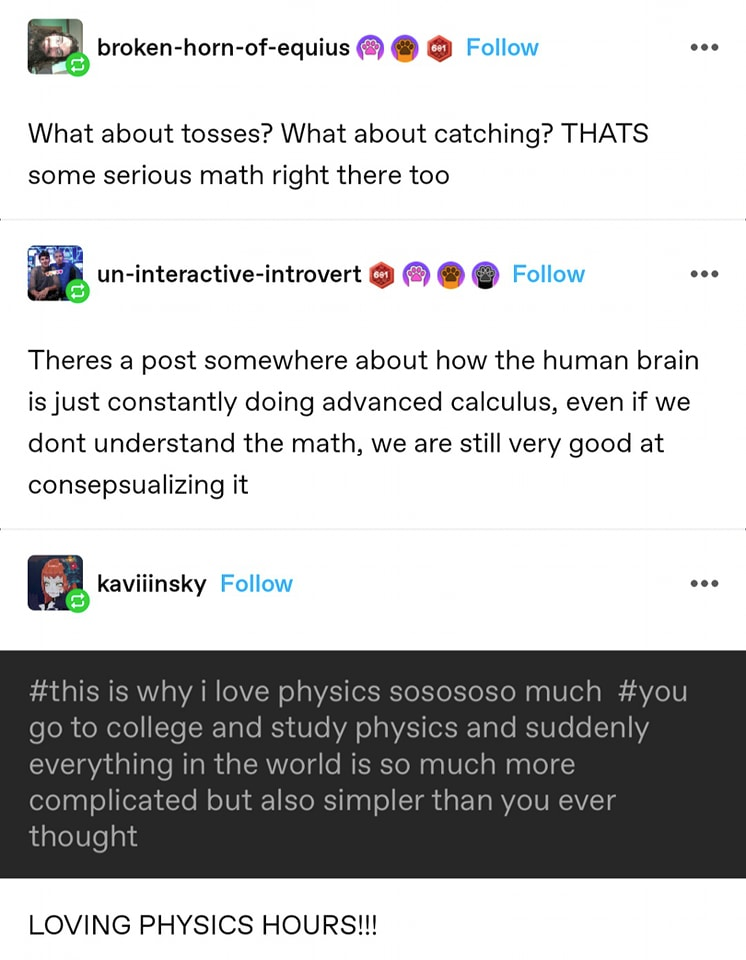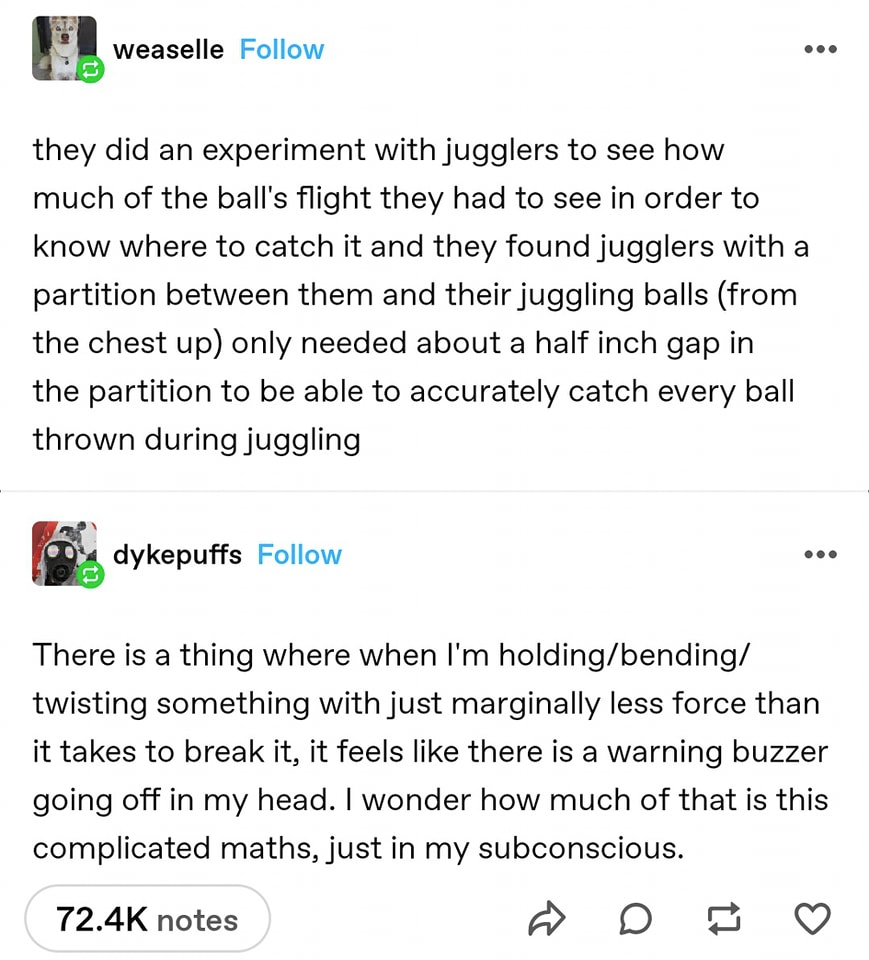

The second thing about microslippage is why I, even though I would say I’m transhumanist, would only ever go full cyborg if the robot parts had a sense of touch.
I don’t wanna pet my dog and not only not feel their fur, but also end up crushing them with my super strength.
I was always amazed at how we can catch objects in flight.
Compared to how long it takes me to calculate projectile momentum in Physics 1
Or tiny birds that can expertly navigate wind currents with an almond sized brain using real-time force feedback. The computational power at their disposal is very well optimized for what they do.
microslippages: some of us just call it what it is … masturbation
Another one is levelling.
A lot of people can see a picture frame is about 0.5° out of level and their fucking eye twitches until they fix it
Me included
That’s nuts when you think about it
See, I live in an old apartment. The corners aren’t 90°, the wall a picture is hanging on is convex. When I’m lying in bed and look at the picture it looks like it’s crooked but I used a level several times on it and it’s as straight as can be. It’s driving me insane.
This is when you set it relative to the rest of the unleveled stuff in your view to make it look level.
But “level isn’t what you need. If the floor and ceiling aren’t level, it’ll look wrong.
When my wife was pissed at me she would go to my office before I got to work and tilt every picture/award and move my books about.
She knows what buttons to push and my sous chefs just let her do it… ungrateful pricks
/S
I purposefully slightly tilt most my wall hangings. I like watching guests squirm when they mention it and I do nothing
We would probably fist fight then, because I’d level it without saying anything, and if you set it back crooked, I would throw it on the ground.
I respect and hate this. I could never
That’s a game that would be hilarious. But yeah, i wouldn’t be able to do it.
Madlad
Sorry cousin, unfortunately I will get the flu this Christmas and won’t be able to come visit.
Our bodies n brains are so cool. Think about what goes into locating a sound in space.
Edit: there’s more to it but at the most basic level your brain calculates the fraction of a second difference between when one ear picks up a sound and when the other does creating a reference point based on that.
I think the “more to it” might be significantly crazier than the timing thing.
Or ears have unique complex shapes that attenuate certain frequencies and bounce sound around in complex ways depending on the direction they ate coming from. And our brains instantly process all that stuff too. It’s why our sense of hearing isn’t just on a flat plane around our head.
My hearing is pretty severely damaged in my left ear, and for several months I thought everything was to my right. but my ability to locate sounds has come back. My hearings not any better, my brain just figured out that my left ears fucked and compensated.
I got into an argument with someone once about this, when they told me (paraphrasing) “it’s safe to drive listening to music through headphones, because they let outside sound in”.
Yes they indeed might, but - even ignoring delay introduced from digital electronics - you’ve now lost all sense of where that sound is coming from, because you’re listening to the sound of one microphone being played through one speaker.
The human ear really is an incredible thing.
Put on some halfway decent headphones and try out the virtual barbershop.
That’s boring. Two ears only allow you to put the sound somewhere on a plane (the vertical one that cuts your body in half lengthwise). How do you know the ‘height’ of the sound on that plane? By utilizing the different distortions the sound goes through while being funneled through your auricle.
You can also detect is the source up or down thanks to ear shape which delays sound for couple of ms.
If you’re about to walk into a bar with you head, or like the top of a doorpost or smt. You’ll instinctively pull back and avoid the obstacle, inches before it hurts, because your brain notice the hairs on your head moved. That’s why men who have recently gone bald, often have bumps and bruises on their head. My bald colleague told me that for him, that was the hardest thing about going bald.
So by that logic, a boxer who shaves his head will take harder hits!
Wow super interesting
Thank you hair! I only cut you out of love!
Throwing and catching always amaze me. And it’s not something that everyone is always great at, for sure, but anyone can try to toss a wad of paper into the waste basket. Whether or not you make it, the calculations under the hood, happening so quickly, always astound me to think about.
What’s amazing is our ability to calculate the path of something in the air.
There’s a test they did with Cristiano Ronaldo where someone kicked a ball to him so he could head it. They shut off the lights before the ball was in the air and somehow from the body shape of the person kicking it, he was able to know how to make contact with it without being able to see it.
I’m not a fan of Ronaldo but that was very cool to watch, thanks for sharing!
I remember when I was younger and would lay on my back throwing a baseball up in the air and catching it, that I could watch it go up and not follow it with my eyes as it goes down and still have my hand in the right spot to catch it
Read somewhere that catching is actually dead simple, just “move towards the image of the incoming target” (I’m not talking about the arm kinematics).
There were a robot paper bin that zoomed under stuff you threw up in the air using no complicated algorithms for example.
Funnily many algos are calked on physical and chemical effects in the real workld, like splines for example were made with a thin metal bar and lead weight bending it to get the lines used in boat hull construction.
When sharpening knives, with practice you can tell when you are done by sliding your fingertips along (not across) the sharpened bevel. It’s possible to feel imperfections measured in micrometers this way.
If the earth were shrank down to the size of a golf ball, you could feel houses.
That seems wildly unnecessary. I can already feel houses.
I’m sure there’s some actual science thing they’re referencing here, but I don’t understand it. Who can’t feel houses?
Both a house and a golf ball are unbelievably tiny compared to the size of the Earth. The idea that you can shrink the Earth many thousands of times over and be able to feel a house parallels with our ability to feel micro imperfections on knife blades.
People without fingers, I guess
Source??
my half a finger
We have equipment to measure down to microns, and my students often test how fine details they can feel.
I mean, most people do it across, rather than along the blade, what with the necessity of detecting a burr, which can’t usually be felt length wise. You slide along the blade, and it is sharp, if you screw up you get cut.
That doesn’t take away from what you’re saying, it’s very true, no matter which direction you’re feeling. Just normal, average fingertips can pick up stuff like that, that you’d need a microscope to see. It’s a trip!
The burr is also detectable lengthwise. When starting with a dull blade it feels smooth while sliding fingers lenghtwise. When the burr is formed, it starts to feel rough. When it feels like it’s digging into skin, it’s sharp. It’s a very subjective thing though, everybody has different fingers.
Is way better to draw your finger perpendicular to the edge to feel the burr. That way you don’t cut yourself on the edge or the burr itself.
A lot of it is the difference between learning practically and learning theoretically. You don’t have to understand the underlying mechanics in practice to know how to keep getting the same result. Your brain doesn’t have to be doing any math, it just has to have shaken a bottle enough times to have a good comparative basis formed.
Learning to calculate the current remaining volume in a container when observing someone else shake it… that would use all that theoretical knowledge and math.
It’s like knowing how hard you have to throw an egg at a wall for it to break instead of bounce off. You do it 100 times, you just get a good feel for it. Doing all the math, and then trying to learn it practically is barely gonna affect how quickly you learn it in practice. But if you wanted to make a robot that throws it exactly hard enough without wasting any energy, practical knowledge will have almost no value, and theory and math will be incredibly valuable.
This is coming from someone who does indeed have the whole “passive trajectory analysis of every moving object around me” thing. I can’t do crowds or drive at busy times. But, for moving through a minor crowd while reading a book, or pulling into a tight parking space while other cars are moving around near me, it’s very helpful. I have good spatial awareness in general, like parking in my garage with only an inch of clearance on the far side of my car has never been an issue in 14 years so far. Or when doing it with someone else’s borrowed car every now and then too. When I shrug off the difficulty of doing something like that, people seem to be amazed. Otherwise, I would have assumed it was normal, feels normal to me.
The overwhelming majority of all neurons in our body are just for controlling movement. Ironically, things like language or creativity require very little of our computing power and might be replicated by machine learning and a sufficiently beefy computer. But complex motor tasks? We’re way ahead of our current tech on that.
Yeap, I work in prosthetics and have to explain to “futurologist” on the internet that we’re never going to see advanced prosthetics that are as functional as your original limbs partly for this reason.
Proprioception is important y’all!
deleted by creator








